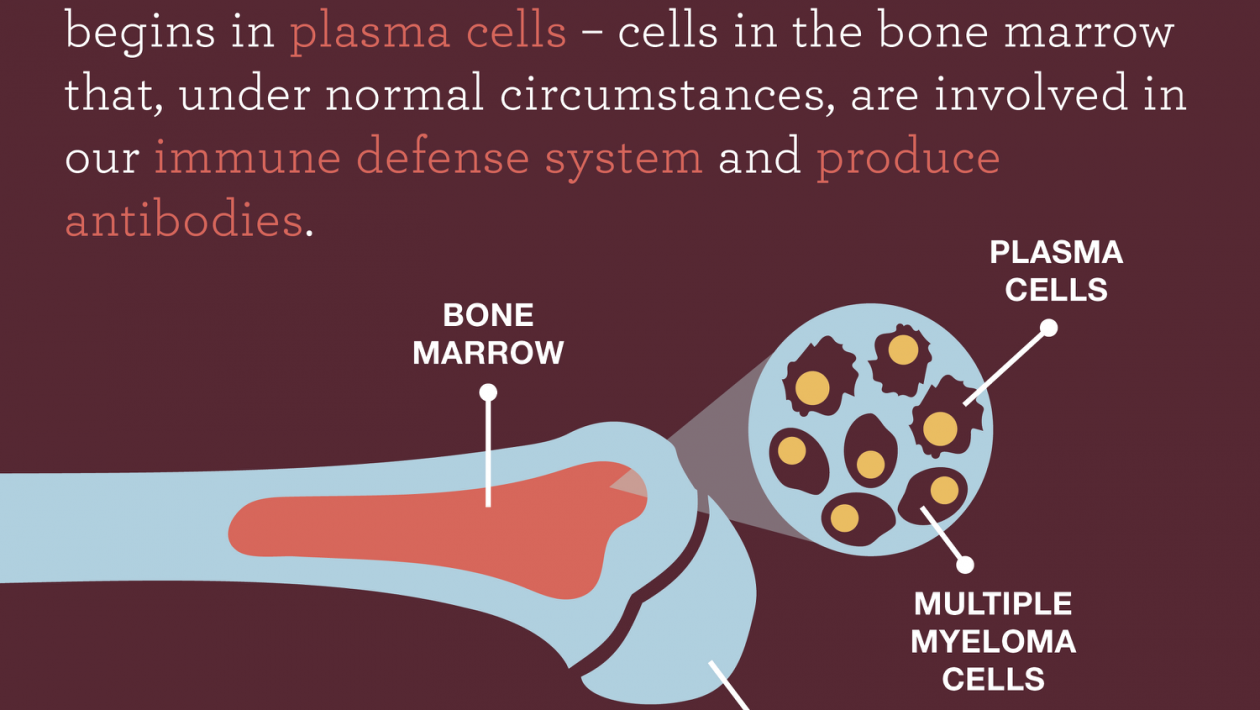The different harmful tumors may be multiple myeloma formed in a type of white physical cell called lymphocytes. Solid plasma cells can help you fight disease by making antibodies that recognize and attack bacteria.
In myeloma, malignant plasma cells gather inside the bone marrow and destroy normal platelets. Diseased cells produce abnormal proteins instead of useful antibodies, which can cause difficulties.
https://www.youtube.com/watch?v=jdytgW5wKa4
Treatment of multiple myeloma is not immediately critical. If myeloma is moderately developed, and there are no strict signs and indications, your primary care doctor can advocate closed observation instead of rapid treatment. For people with myeloma, the World Health Organization needs treatment, and its decision-making area department provides a variety of decisions to help executives get sick.
Table of Contents
Indications multiple myeloma
The signs and indications of myeloma will change and will appear in time within the disease, or it may not.
When signs and side effects do occur, they will include:
Bone pain, especially in your spine or chest
nausea
Work stoppage
Loss of desire
Confusion or confusion
weakness
Continuous pollution
reduce weight
Leg discomfort or performance
Unnecessary thirst
When to check experts
If you have any signs or signs of stubbornness that make you feel stressed, make a plan with the PCP.
the reason multiple myeloma
The causes of threatening tumors are not satisfactory.
Experts have discovered that harmful tumors start from abnormal lymphocytes in the bone marrow-delicate tissue filled with blood that fills most bones' focus. Irregular cells replicate efficiently.
Since malignant growth cells do not bite the dust like traditional cells, they will aggregate and eventually overwhelm the accumulation of sound cells. In the bone marrow, harmful tumor cells release stable platelets, causing the weak partner to lose the ability to fight disease.
Harmful tumor cells have been working hard to provide antibodies, just like sound plasma cells. In any case, dangerous tumor cells produce irregular antibodies that the body cannot use. When all conditions are the same, strange antibodies (monoclonal protein or M protein) can develop in the human body and cause kidney mischief and other problems. Disease cells can even infer damage to bones, which increases the risk of bone fracture.
Multiple myeloma
Various myelomas may be malignant tumors that affect plasma cells. The plasma cell area unit is the white parenchymal cells found in the bone marrow. It is the fragile tissue inside most of your bones that produces platelets. In the bone marrow, plasma cells build antibodies. These regional units of protein can promote your body to get rid of disease and pollution.
Once abnormal lymphocytes of the accompanying degree are produced in the bone marrow and replicate rapidly, different myelomas will occur. The stopgap of harmful or destructive threatening tumor cells ultimately exceeds the accumulation of solid cells in the bone marrow. Subsequently, unhealthy cells accumulate in the bone marrow, forming healthy white platelets and red platelets.
Like stable platelets, malignant cells also try and build antibodies. Regardless, they will specifically produce abnormal antibodies called proteins or M proteins. When these harmful antibodies accumulate in the body, they can cause excretory organ mischief and cause significant problems.
As Stanford University pointed out, myeloma is not common, accounting for only one per cent of all malignant growth cases in the United States. In 100,000 district units, five people have been determined to have this disease.
Types of myeloma
Two principle classification of regional units with myeloma. They are sorted according to their physical results:
Drowsiness-risk tumors do not cause noticeable side effects. It usually grows gradually and does not cause bone tumors. The only M macromolecules and M plasma cell domain units seen hardly increase.
A single tumor creates a tumor in most bones. It usually responds well to treatment and requires close attention anyway.
Which area are the side effects of different multiple myeloma?
The indications for myeloma vary from individual to individual. At first, the signs may not be recognized. Given that the disease is developing, most people can master at least one skill in everything related to various side effects. These side effects area units are usually represented by the word structure CRAB, which means:
calcium
Kidney disappointment
Iron deficiency
mischief
The Ca's undeniable level in the blood will disappear from the affected bones, and these Ca levels are not appropriate. Unreasonable Ca measurement will lead to:
thirst
disease
Reflection
Abdominal restlessness
Loss of desire
Confusion and pause are the primary manifestations of elevated calcium levels.
The disappointment of the kidneys is caused by a large number of M macromolecules in the body.
Weakness may be that the blood needs more red stable platelets to keep the components in other parts of the body. This happens once the malignant cells include red platelets in the bone marrow. Paleness usually causes weakness, numbness and touch.
Once harmful cells attack bone and bone marrow, bone wounds, and cracks will occur. So, these injuries are shown as openings on X-ray pictures. They usually cause bone torture, especially in:
Back
pelvis
rib cage
skull
Additional side effects of myeloma may include:
Disadvantages or side effects, especially in the legs
Accidental weight loss
confusion
Discharge problem
nausea
Withdraw
Rehabilitation disease
Low vision or vision problems
What causes different multiple myeloma?
The specific explanation for myeloma is unclear. Nevertheless, it started with a strange type of lymphocyte, which rapidly increased in the bone marrow more times than it should.
The following destructive and threatening tumour cells do not have a regular life cycle. They did not increase as a result but continued to separate indefinitely. This can overwhelm the body and weaken the accumulation of sound cells.
Which areas are the threat factors for many myelomas?
Individuals are at risk of developing myeloma if:
male
Over fifty
African American
Overweight or extensive
Present to radiation
Used in the oil business
Another dangerous problem of myeloma may be in the context of uncertain pathology (MGUS). This is usually the condition for plasma cells to provide M protein. It usually does not cause any problems. Nevertheless, in the long run, MGUS will eventually become myeloma.
How to analyze myeloma?
Experts usually spot myeloma before they see any signs. Routine physical examinations, blood tests and urine tests will find evidence of this malignant growth.
If your PCP finds signs that threaten the tumour without side effects, more tests are needed. Using subsequent tests, your primary care doctor will screen for the disease's movement and check if you need treatment.
Blood and urine tests
The blood and urine test area unit will not check for M protein. These proteins can also be caused by myeloma or selective diseases. The cancer-causing cells jointly assemble a large molecule called β-2 microglobulin, which may be found in the blood. Blood tests cannot even assess:
The level of plasma cells in the bone marrow
Kidney performance
Platelet test
Calcium level
Urine corrosion level
Image inspection
X-rays, MRI output, or CT filters cannot confirm whether myeloma has broken bones.
Biopsy
In the demonstrative test, your PCP eliminated the lowest bone marrow sample with all-inclusive needles. After obtaining the model, it will be examined in a facility of excellent research significance to cause cancer cells. Various tests will examine the irregular classification within the enclosure and how the cell area unit quickly replicates.
These classifications of test area units will not check whether you have myeloma or other conditions. On the chance of discovering myeloma, it will show progress anyway. It is often mentioned that this is a tissue disease.
arrangement
Try to arrange various myelomas by:
Platelet test
Protein levels in blood and urine
Calcium levels in the blood
There are two ways of organizing myeloma in territorial units. The Durie-Salmon framework depends on macromolecule level; M, calcium and red platelets, but it is based on the level of hoaxes. The international staging system depends on plasma and β-2 microglobulin levels.
These two frameworks divide the conditions into three stages, and the third stage is an extreme situation. Arrangements can help your PCP check your opinions and treatment decisions.
How is multiple myeloma treated?
There is no solution for myeloma. Nevertheless, some regional unit drugs can encourage people to reduce pain, reduce complexity, and reduce disease movement. If the disease is getting more and more serious, use the medicine field unit exclusively.
Your PCP may not recommend treatment when you do not experience any symptoms. When all conditions are the same, your primary care doctor can focus on examining your need to look for signs of disease progression. So, this usually includes regular blood and urine tests.
Even If you may need treatment, the primary decision encapsulates the following:
Guide clinical considerations
Drugs that guide clinical considerations will stop a substance in dangerous tumour cells that will destroy the protein, allowing diseased cells to continue to spread. The medications used through key clinical considerations are usually bortezomib (Velcade) and carfilzomib (Kyprolis). Each area unit is adjusted by vein or arm vein.
Natural clinical considerations
Organic clinical considerations drugs use your body structure to attack dangerous tumour cells. In some cases, a pill combination of anaesthetic enhancing drugs (Thalomid), lenalidomide (Revlimid) or pomalidomide (Pomalyst) cannot help build the framework.
Lenalidomide is equivalent to a narcotic anaesthetic; in any case, it has little effect on fluoroscopy. All in all, this is more difficult.
Chemotherapy
Chemotherapy is a compulsory classification of partners in clinical considerations of drugs, which can help kill invasive cells, just like dangerous tumor cells. So, the therapeutic drug is usually administered to regional units in high doses, especially before physical cell migration. So, the medicine can also be taken intravenously or in pill form.
Corticosteroids
Corticosteroids are similar to liquid vixen and dexamethasone fortifiers and usually do not treat harmful tumors. So, they will adjust the framework by reducing the body's stimulus, so they typically have a decisive role in eliminating dangerous tumor cells. They will be taken in pill form or intravenously.
Radiology clinical considerations
Radiation therapy uses long-lasting light to destroy threatening tumor cells and stop their development. So, this kind of treatment usually does not quickly execute dangerous tumor cells in the human body's total confinement. For example, once a bunch of abnormal plasma cells called a tumor a tumor that can cause torture or crush bones, it should do so.
Unexplored cell transfer
So, the essential microbial transfer includes trade pathological bone marrow and solid bone marrow from contributors. Before using this technology, the blood's basic microbial area units will be collected from your blood. Then use therapy or most therapy to treat myeloma.
Elective prescription
Selective drugs have aroused widespread popularity to solve myeloma indications, so they have a vision for the treatment of the disease. Although they cannot treat myeloma, you want to tell your primary care doctor about the following:
Also, Acupuncture
So, Perfume care
rub
Also, meditation
Unwinding procedure
Before trying to confirm that they are in good health with you, discuss various treatment options with your primary care doctor.
Which areas of confusion are distinguished from different myeloma?
In any case, various myelomas can cause some confusion, but they can usually be treated:
So, Treat contaminants with anti-infectives.
Also, drug clinical considerations can reduce or alleviate bone misfortune.
Use glycoprotein to treat weakness. So, this drug can make the body vigorous, thus providing extra red platelets.
Set moderate goals
Also, stimulate your enthusiasm by defining reasonable goals that provide you with a way to execute people for your situation. However, try not to set too ambitious targets for regional units. Therefore, doing so will bring fatigue and disappointment.
Pay attention to your overall health.
Make sure you eat enough nutrients and get enough rest. So, trying low-power exercises (such as walking or yoga) a few times a week is even valuable. Also, keeping your body and brain as healthy as possible will help you better adapt to the stress and fatigue caused by malignant growth. To ensure that you have enough opportunities to rest and regain strength. So, please do not over-arrange your schedule.










